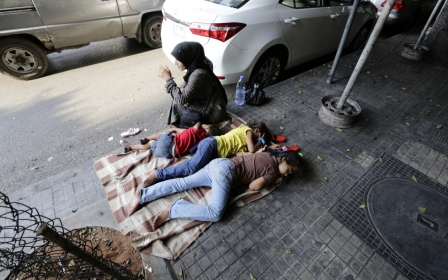Lebanon-Syria timeline: 1976-2014

Timeline of relations since 1976 between Damascus and Lebanon, which, overwhelmed by a massive influx of refugees from Syria's civil war, began imposing Monday unprecedented visa restrictions on Syrians.
- June 6, 1976: A year after the start of the Lebanese civil war, Syrian troops enter the country at the request of Christian groups.
- March 16, 1977: Druze leader Kamal Jumblatt is assassinated.
- July, 1978: Shelling of Beirut's Christian neighbourhoods by the Syrian army after a change of alliance, having sided with mostly Muslim and Palestinian leftist forces.
- June, 1982: Israeli forces invade Lebanon, sweeping into Beirut. In September, Syrian troops pull back to the east of the country while Palestinian fighters move east and north.
- February, 1987: With the civil war still raging, some 8,000 Syrian soldiers are deployed in west Beirut.
- October 22, 1989: Lebanese inter-party talks in Taif, Saudi Arabia, produce an agreement that will in 1990 end the civil war. The deal calls for a Syrian pullback to the east of the country, but does not set a date for a full withdrawal.
- May 22, 1991: Lebanon and Syria sign a friendship treaty, which sets Syria's dominating role in stone.
- October 15, 1998: Emile Lahoud, a pro-Syrian general, is elected president of Lebanon.
- April 16, 2001: An Israeli raid against a Syrian position after an attack by Lebanese Shiite movement Hezbollah. The bulk of the Syrian army deploys to the Bekaa Valley, in the east.
- September 2, 2004: The UN Security Council adopts Resolution 1559 calling for the withdrawal of foreign forces from Lebanon and respect for its sovereignty.
- February 14, 2005: Anti-Syrian Prime Minister Rafiq Hariri is assassinated. His supporters accuse Syria of ordering the killing but Damascus denies any involvement.
- April 26: The last Syrian troops leave Lebanon after 29 years of presence, under pressure from the street, the opposition and the international community.
- May 7, 2008: The start of clashes between Hezbollah, backed by Syria and Iran, and government supporters, backed by Saudi Arabia and the US. Nearly 100 die in one week.
- May 25: Army chief Michel Sleiman is elected Lebanon's 12th president after a deal between the government and opposition in Doha.
- October 15: Lebanon and Syria formally establish diplomatic relations for the first time since they emerged as independent states after World War II.
- March 15, 2011: Start of the conflict in Syria, which will develop into a devastating and complex civil war.
Lebanon's government, where more than 1.1 million Syrians have found refuge, is split between supporters of the Syrian government, including Hezbollah, and backers of the uprising, making any decision on the refugees difficult.
Stay informed with MEE's newsletters
Sign up to get the latest alerts, insights and analysis, starting with Turkey Unpacked
Middle East Eye delivers independent and unrivalled coverage and analysis of the Middle East, North Africa and beyond. To learn more about republishing this content and the associated fees, please fill out this form. More about MEE can be found here.




